Southwest Michigan field crop update – July 16, 2020
Hot and dry conditions give way to slightly cooler temperatures and an upcoming extended period of possible wet weather—scouting focus may need to shift.

Weather
The warmer-than-normal trend for the summer continues, although this was moderated somewhat with cooler temperatures this week. Rainfall on July 10 and 15-16 helped to make up for the nearly two previous weeks without rain. Much of the state remains in need of more rain, as is seen by the newly updated U.S. Drought Monitor, and unfortunately the system that just made its way through did not supply that much to the eastern half of the state. A high pressure system moving into the state Friday, July 17, will give way to a low pressure system over the weekend, bringing high heat and humidity over the weekend with heat indices near 100 degrees.
Our next chances of rain will be Sunday through Wednesday next week with as much as 1 inch predicted for the southwest. The 6-10 and 8-14 day outlooks both call for a very high chance of above-normal temperatures for the rest of the month. Warmer-than-normal conditions are expected to continue into August, but Michigan State University Extension agricultural climatologist Jeff Andresen says there may be signs that a cooling trend will bring more normal temperatures next month.
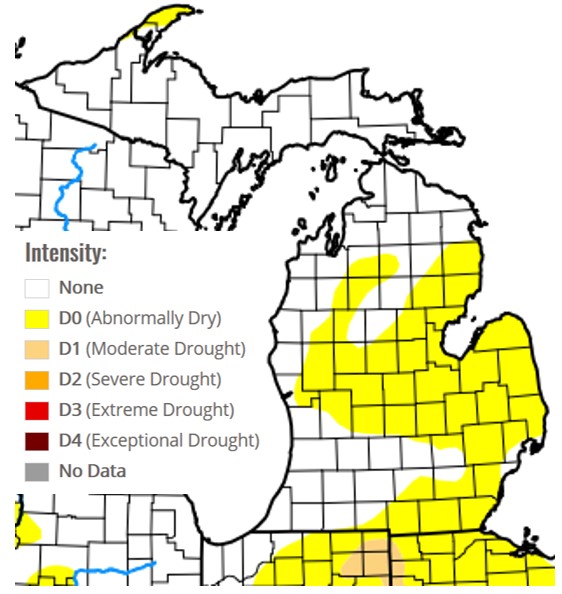
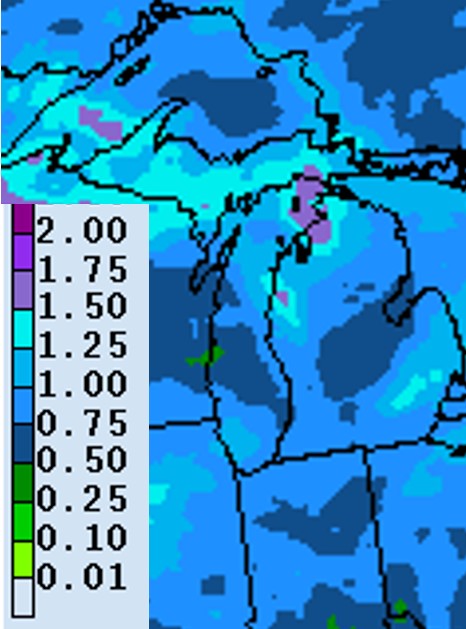
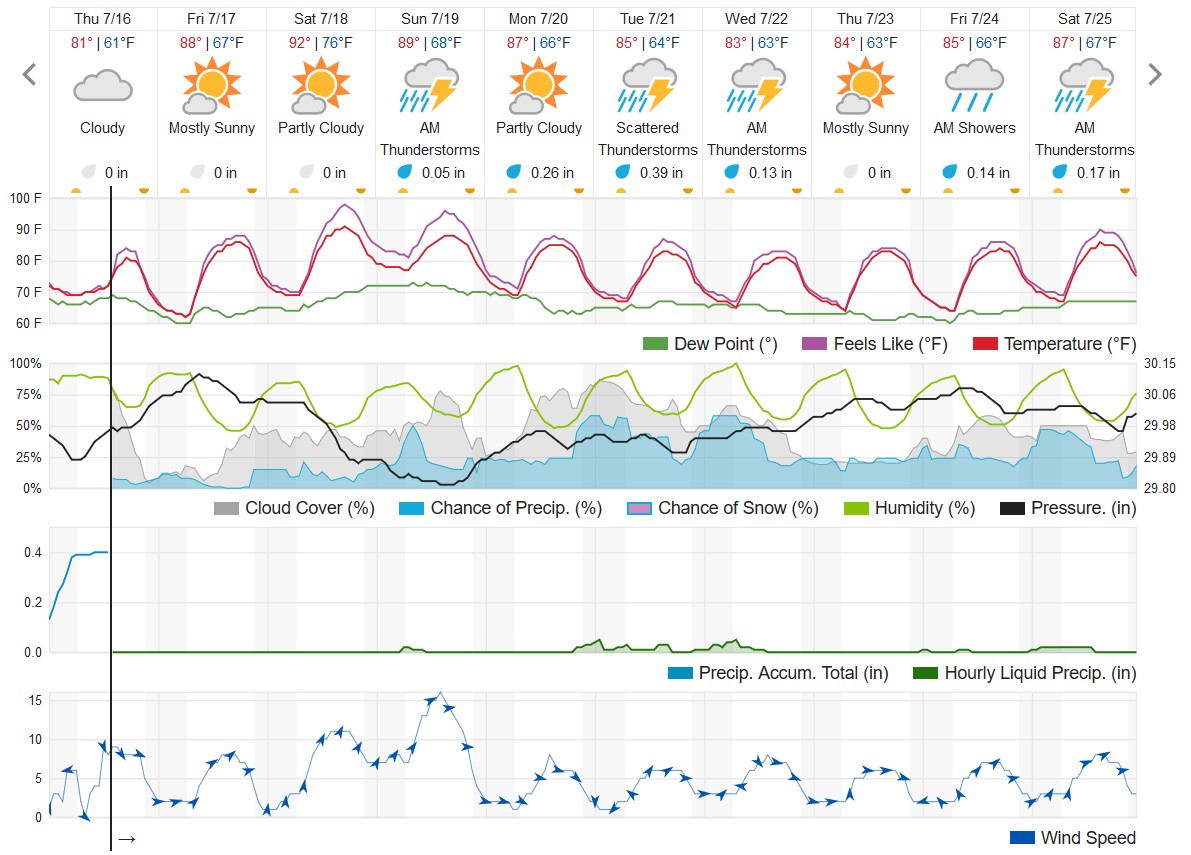

Crops
Early planted corn is tasseling while later planted corn is around V7-V8, with a few later planted fields further behind. Fields that have received adequate moisture over the past week look excellent, although wide variability can be seen in many fields.
Early planted soybean fields are well into flowering. Early (R1) and full (R2) bloom are when white mold is a concern, as the spores infect flower petals. However, even in irrigated fields with tighter row spacing, conditions so far this season have not been conducive to white mold, although we’ll see whether the extended period of rainfall in the coming week may push humidity levels in the canopy.
Edges of many fields throughout the region are showing spider mite injury symptoms—no bronzing, just yellowing so far. If we do get an extended period of moisture this week, that may provide good conditions for the fungal pathogen that keeps spider mite populations in check.
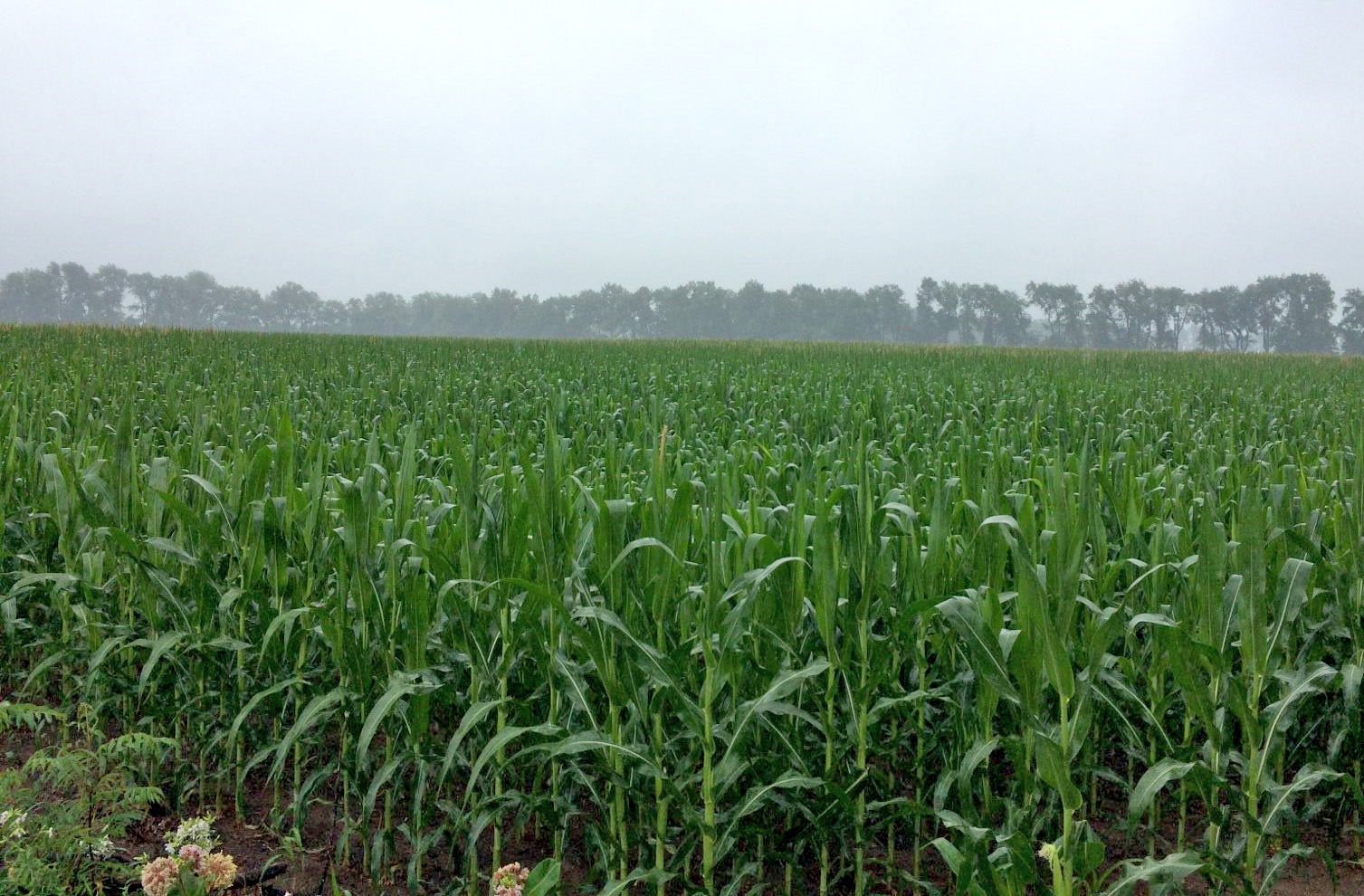
Pests
The first tar spot lesions are being found in northwest Indiana. They have had more rain than us, so not much of a surprise. If we have an extended period of wet weather as is predicted Sunday through Wednesday, we may see an advance in this disease. Also, look for gray leaf spot this season given that the temperatures are expected to soar soon and hot and wet is the perfect scenario for trouble.
Fungicide applications should be targeted at both diseases, especially where extended leaf wetness may cause infection periods. MSU Extension field crops pathologist Marty Chilvers has said that a fungicide application at or shortly after tasseling has proven most effective in reducing tar spot severity. Chilvers will be presenting on tar spot and white mold during the MSU Extension Field Crops Virtual Breakfast on July 23 at 7 a.m.
Sign up to receive Virtual Breakfast Zoom information
MSU Extension field crops entomologist Christina DiFonzo was featured on this week’s Field Crops Virtual Breakfast where she talked through numerous insect species and what we should be monitoring, including tarnished plant bug, potato leafhopper, spider mites, ear-feeding caterpillars and more. She showed pictures of spider mite symptoms in soybean and corn, advised when insecticide applications may be warranted and most effective, and pointed to additional resources at the MSU Extension Field Crops Entomology Program website.
Asiatic garden beetle adults were emerging later this year in fairly high numbers. Reports of damage on fruit and flowers have come in from growers. Look for them at night, especially around brightly lit areas. This pest continues to become more prevalent and might warrant using soil insecticide routinely in areas that have had issues.
Epic numbers of potato leafhoppers have caused damage in regrowth of second cutting in alfalfa. DiFonzo says the best treatment is to cut if possible, and if insecticides are warranted, be mindful of the harvest intervals. Several participants on the Field Crops Virtual Breakfast all commented on the improvements in resistance of current alfalfa varieties to leafhopper, although it was mentioned that damage will still occur with severe infestations.
Water usage and irrigation
With the hot weather subsiding a bit this week, daily potential evapotranspiration (PET) rates were slightly lower than last week. From the MSU Enviroweather reference PET screenshot below for Kalamazoo, we can get a more precise estimate of water use needs. Corn from tasseling through beginning dent (VT-R5) has a crop coefficient (Kc) of 1.2; soybean has a Kc of 1.0 and 1.1 at R1 and R2, respectively (from “Soil Water Balance Sheet”). Multiplying the daily rPET by the current Kc gives the crop daily water use. If we get 1.0 inch of rain in the coming week, corn at VT or R1 (silking) will require an additional 0.75 inch of water and soybean at beginning bloom (R1) will require 0.5 inch.
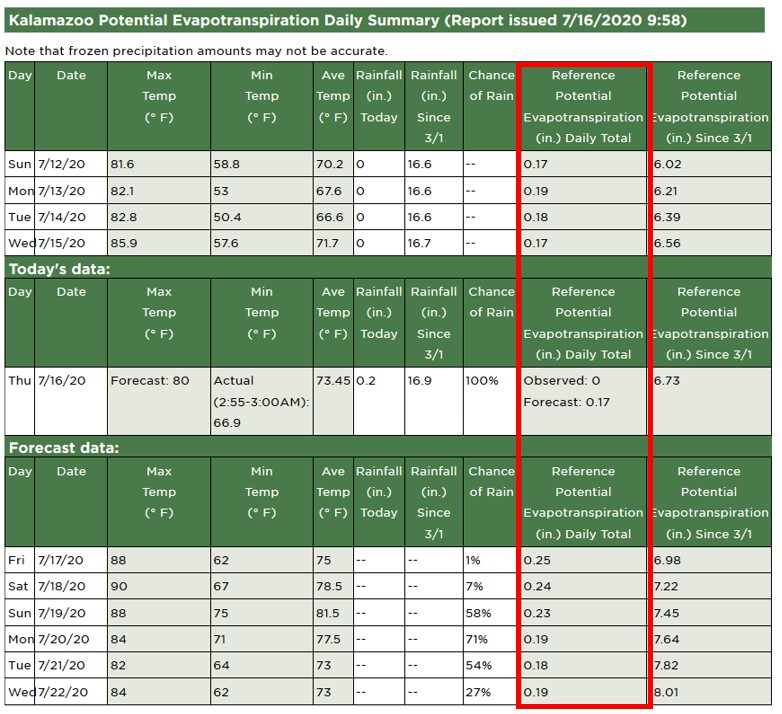
|
Crop water use estimate for corn at tasseling (VT) and soybean at beginning bloom (R1) for Kalamazoo during the coming week. | |||
|---|---|---|---|
|
Date |
rPET |
Crop water use | |
|
Corn Kc=1.2 |
Soybean Kc=1.0 | ||
|
16-Jul |
0.17 |
0.20 |
0.17 |
|
17-Jul |
0.25 |
0.30 |
0.25 |
|
18-Jul |
0.24 |
0.29 |
0.24 |
|
19-Jul |
0.23 |
0.28 |
0.23 |
|
20-Jul |
0.19 |
0.23 |
0.19 |
|
21-Jul |
0.18 |
0.22 |
0.18 |
|
22-Jul |
0.19 |
0.23 |
0.19 |
|
Week |
1.45 |
1.74 |
1.45 |
For those needing to finish nitrogen fertilization through the pivot, here are a few thoughts from Lyndon Kelley’s article, “Last-chance nitrogen application with irrigation.”
Irrigated production has the advantage of fertigation as an option in nitrogen management. Fertigation is the process of applying fertilizer through irrigation water. Liquid 28% nitrogen is the most common product for fertigation, but urea and micronutrient solutions are also available to meet crop nutrient needs, with proper equipment. Fertigation makes up the remainder of the budget (following starter and sidedress) supplying nitrogen to the crop just prior to tassel emergence. For efficient use, nitrogen applications need to be made prior to tasseling or soon after to ensure the nitrogen applied is in an available form for the plant to uptake and use during early grain formation.
As an example, let’s say you have a 210-bushel yield goal on an irrigated field that calls for 230 pounds of nitrogen. At planting, you apply 30 pounds of nitrogen followed by 120 pounds applied at cultivation in early June. No nitrogen credit is given because of sandy soils and the continuous corn production. This leaves a nitrogen need of 80 pounds. You decide to apply the remaining 80 pounds split into two 40-pound applications through the irrigation. We get about 3.1 pounds of actual nitrogen for each gallon of 28% nitrogen applied. You calculate that you need to apply just short of 13 gallons per acre. Knowing that your system irrigates two acres per hour, you calculate that you need to inject 26 gallons of the fertilizer per hour.



 Print
Print Email
Email